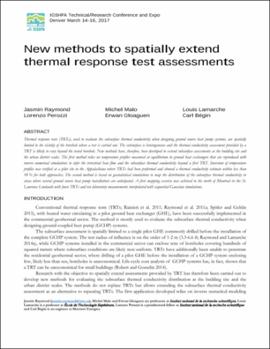| dc.contributor.author | Raymond, Jasmin | |
| dc.contributor.author | Malo, Michel | |
| dc.contributor.author | Lamarche, Louis | |
| dc.contributor.author | Perozzi, Lorenzo | |
| dc.contributor.author | Gloaguen, Erwan | |
| dc.contributor.author | Bégin, Carl | |
| dc.contributor.other | IGSHPA Technical/Research Conference and Expo (2017) | |
| dc.date.accessioned | 2017-03-06T15:38:27Z | |
| dc.date.available | 2017-03-06T15:38:27Z | |
| dc.date.issued | 2017 | |
| dc.identifier | oksd_igshpa_2017_Raymond | |
| dc.identifier.uri | https://hdl.handle.net/11244/49336 | |
| dc.description.abstract | Thermal response tests (TRTs), used to evaluate the subsurface thermal conductivity when designing ground source heat pump systems, are spatially limited to the vicinity of the borehole where a test is carried out. The subsurface is heterogeneous and the thermal conductivity assessment provided by a TRT is likely to vary beyond the tested borehole. New methods have, therefore, been developed to extend subsurface assessments at the building site and the urban district scales. The first method relies on temperature profiles measured at equilibrium in ground heat exchangers that are reproduced with inverse numerical simulations to infer the terrestrial heat flow and the subsurface thermal conductivity beyond a first TRT. Inversion of temperature profiles was verified at a pilot site in the Appalachians where TRTs had been performed and showed a thermal conductivity estimate within less than 10 % for both approaches. The second method is based on geostatistical simulations to map the distribution of the subsurface thermal conductivity in areas where several ground source heat pump installations are anticipated. A first mapping exercise was achieved to the north of Montreal in the St. Lawrence Lowlands with fours TRTs and ten laboratory measurements interpolated with sequential Gaussian simulations. | |
| dc.format | application/pdf | |
| dc.language | en_US | |
| dc.publisher | International Ground Source Heat Pump Association | |
| dc.rights | In the Oklahoma State University Library's institutional repository this paper is made available through the open access principles and the terms of agreement/consent between the author(s) and the publisher. The permission policy on the use, reproduction or distribution of the article falls under fair use for educational, scholarship, and research purposes. Contact Digital Resources and Discovery Services at lib-dls@okstate.edu or 405-744-9161 for further information. | |
| dc.subject | heat pumps | |
| dc.subject | thermal conductivity | |
| dc.title | New methods to spatially extend thermal response test assessments | |
| osu.filename | oksd_igshpa_2017_Raymond.pdf | |
| dc.identifier.doi | 10.22488/okstate.17.000519 | |
| dc.type.genre | Conference proceedings | |
| dc.type.material | Text | |
